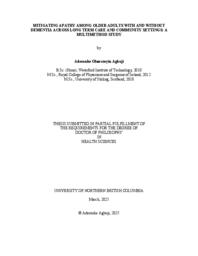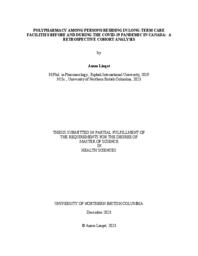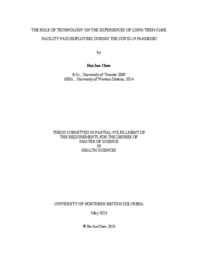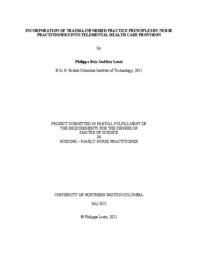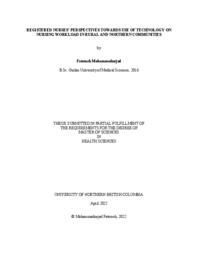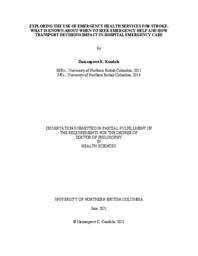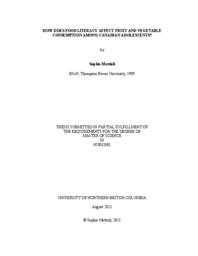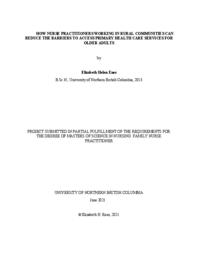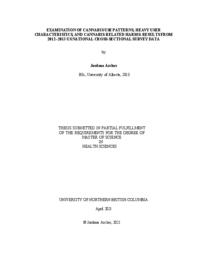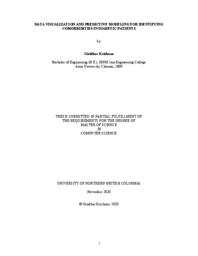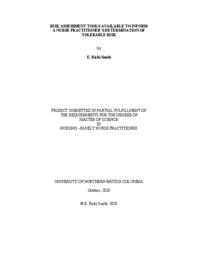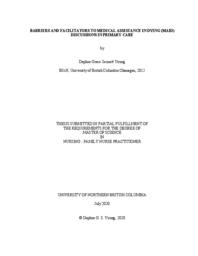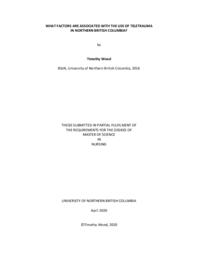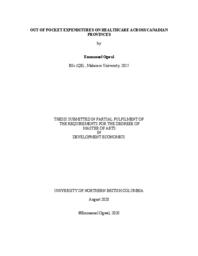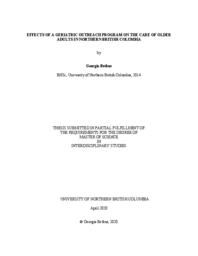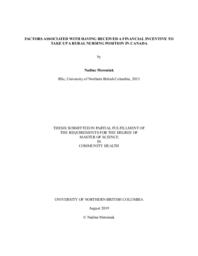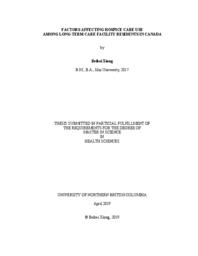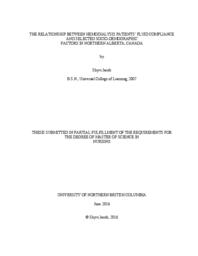Freeman, Shannon
Person Preferred Name
Shannon Freeman
Related Works
Content type
Digital Document
Origin Information
Content type
Digital Document
Origin Information
Content type
Digital Document
Origin Information
Content type
Digital Document
Description / Synopsis
The COVID-19 pandemic led to substantial changes in technology use within the long-term care (LTC) sector in Canada. The purpose of this research was to describe the use of technology and its impact on the experiences of LTC staff working in northern British Columbia (B.C.) during the COVID-19 pandemic. A secondary analysis of one-hour semi-structured interviews from 53 participants was conducted. Data was analysed thematically guided by Braun and Clarke’s thematic analysis approach. The experiences of LTC staff varied across disciplines and work roles. LTC staff reported using technologies for inter-department, intra-department or inter-professional communications, as well as to enhance residents’ social interactions. Findings provide insight into the perspectives of LTC staff who had to adopt new technologies and new work processes during COVID-19, thus informing and providing actionable insights for those working in northern B.C.
Origin Information
Content type
Digital Document
Description / Synopsis
The Canadian population is aging, and rates of obesity are also on the rise. These demographic changes have implications for the long-term care (LTC) system in Canada that need to be better understood, yet little is known about the population with obesity in Canadian LTC. In this thesis, an exploratory analysis of residents newly entering LTC between 2010 and 2020 is provided. Cross-tabulations and chi-squared statistical testing (p≤0.001) were employed to analyze retroactive, consecutive cross-sectional initial assessment data (N=350,348) from the Canadian Institute for Health Information’s (CIHI) Community Care Reporting System (CCRS) to explore the levels of obesity, demographic characteristics (age, sex, primary language, rural or urban previous residency), rates of health conditions, and independence and assistance levels of activities of daily living (ADLs). Over the full study period, the rate of obesity for the population entering LTC was 19%, and 7% entered with at least class II obesity (≥35 kg/m2). Rates of obesity and BMI obesity categories tended to increase incrementally over the course of the study period. Those entering LTC with obesity were more likely to be younger, female, English/French speaking, and arriving from rural areas. Individuals with obesity had lower rates of dementia and higher levels of independence when performing ADLs. They also exhibited higher rates of diabetes and a greater need for two+ person assistance for ADLs. This thesis begins to fill in the gap in our understanding of the population with obesity in LTC, providing a broad picture of the heterogeneous nature of the population, including important differences in health and ADL profiles across the three obesity BMI categories (i.e., classes I-III).
Origin Information
Content type
Digital Document
Description / Synopsis
A trauma-informed approach to care incorporates awareness of the how trauma, a highly prevalent experience, impacts multiple aspects of health and influences an individual’s experience of health care. Nurse practitioners working within the primary care context frequently care for complex patients with a high burden of trauma and negative past experiences with the healthcare system. It is essential that nurse practitioners are equipped to provide care that is trauma-informed, regardless of its mode of delivery. Though some trauma-informed care guidelines are available, no specific guideline is available to guide its application specific to telemental health care. Therefore, the goal of this project was to explore how nurse practitioners can incorporate the principles of trauma-informed care into their provision of telemental health care. An integrative literature review was conducted, using the framework of the Substance Abuse and Mental Health Services’ model of trauma-informed care to guide keyword selection. The initial search yielded 1028 results; after application of inclusion and exclusion criteria, a total of 15 articles were included in the review. Data relevant to the research question was extracted and collated, and the following areas were summarized: how trauma was conceptualized, how telemental health care was delivered and integrated into larger systems of care, and how each of the assumptions and principles of trauma-informed practice were demonstrated. From these findings, intrinsic characteristics of telemental health care were identified, and a model of trauma-informed telemental health care specific to the scope and context of family nurse practitioners in primary care. Recommendations for practice were made based on how nurse practitioners can capitalize on those characteristics of telemental health care that align with a trauma informed approach, including the option to avoid entering unsafe physical health care spaces, reduction of number of people in the room during vulnerable procedures, inclusion of family, friends, and community, adaptability to patient needs and preferences, access to a more diverse selection of services, and convenience. Further recommendations for practice were made to guide nurse practitioners in mitigating the risks associated with those characteristics of telemental health care that challenge the provision of trauma-informed care, including physical separation from the patient, need for patients to place an additional layer of trust in providers to take appropriate security precautions, loss of a private space provided by in-person appointments, risk of triggering and recreating traumatic experiences that involved technology, and inaccessibility of services based on their technology-related knowledge and material requirements. Finally, recommendations were made for how policy and research can address gaps in knowledge and actions required that fall beyond the scope of individual practitioners. This review suggests that while nurse practitioners cannot use telehealth as the sole vehicle through which they offer their patients trauma-informed mental health care, the principles of trauma-informed care can be incorporated into telemental health care in ways that enhance the nurse practitioner’s ability to avoid retriggering trauma, support the establishment of trust in patient-provider relationships, and take steps towards overcoming trauma-related health inequity.
Origin Information
Content type
Digital Document
Description / Synopsis
Background: Technology has an important role in health delivery. One of the uses of technology in the healthcare field is to reduce Registered Nurses’ (RNs) workload. Reducing RNs’ workload can increase health delivery efficiency. Objective: To find out RNs’ perspectives towards the use of technology, including the Steadiwear glove, on their workload in rural and northern communities. Methods: A literature review was conducted, guided by a scoping review methodology and 35 articles were included. Subsequently, semi-structured interviews were conducted with eleven RNs who shared their perspectives towards technology use on their workload. Thematic analysis and an inductive approach guided by Creswell and Creswell, (2018) was undertaken. Results: Two main themes and six subthemes about the effects of technology use on RNs’ workload were found. The results revealed some technologies like the Steadiwear glove have the potential to decrease RNs’ workload by increasing the independence of persons' living with Essential Tremor (ET) and Parkinson’s Disease (PD). Further, the results demonstrated participants’ perspectives towards five technology categories including, Information and Communication technologies, E-communication, E-learning, mHealth, and Assistive devices. Elearning was the technology most commonly described by the participants and mHealth use was described the least. Factors such as decision-making based on urban setting, technology resources, and suitable training and support for using technology may affect RNs’ workload. Conclusion: Different types of technology may affect RNs’ workload depending on factors such as nurses’ acceptance, patients’ acceptance, educating users, healthcare setting (urban or rural), and technology support.
Origin Information
Content type
Digital Document
Description / Synopsis
Transport practices for seeking emergency stroke care remain largely underresearched and poorly understood, particularly for individuals living in small urban, rural, and remote regions. This multi-method study aims to address this knowledge gap and explores the impact of mode of transport on in-hospital stroke care and the decision-making process of seeking emergency medical attention for patients and their caregivers. Data from the Discharge Abstract Database provide information on stroke-related use of emergency health services across British Columbia. Data from the Canadian Institutes for Health Information Special Project 340 provide information on if calling emergency health services impacts the delivery of care, including the completion of neuroimaging, the administration of acute thrombolysis, and the prescription of antithrombotics upon discharge across a northern health region. Focused, semi-structured interviews provide contextual insight into the decision-making processes for seeking emergency stroke care among patient and caregiver participants in a northern health region. Stroke-related emergency health service use across British Columbia from January 2015 to March 2018 was 67.9% (N=19,849), ranging from 58.8% in Northern Health to 70.2% in Fraser Health. In Northern Health (N=784), there were differences between health service delivery areas for stroke-related emergency health service use ranging from 53.7% in the Northwest to 64.8% in the Northern Interior from January 2015 to March 2018. Similar differences in thrombolytic therapy administration and the prescription of antithrombotics were noted. The odds of emergency health service use were greater for those 65 years of age and older than those younger than 65 and lower for those in the Northwest health service delivery area than those in the Northern Interior health service delivery area. Differences were found for the completion of neuroimaging between males and females. Interviews for patient (n=12) and caregiver (n=7) participants provide complementary contextual insights and yielded three key themes, including the decision-making process following a stroke, experiences of care, and perceived gaps and areas in need of further support. This integrated knowledge translation-informed and practice-driven research addresses health services and policy priorities. Findings are anticipated to help inform the development and refinement of emergency health services in British Columbia by highlighting differences in emergency health services use across geographies and identifying factors that inform patient decisionmaking when seeking emergency medical attention.
Origin Information
Content type
Digital Document
Description / Synopsis
Background. Adolescents are losing the opportunity to observe and practice food skills since diets are shifting from home prepared meals made from basic ingredients to a diet comprised of ultra-processed foods, resulting in reduced consumption of minimally processed foods such as fruits and vegetables. Evidence suggests that engaging in food preparation during adolescence is associated with ongoing healthy dietary behaviours and food preparation practices into adulthood, thus developing food preparation skills in adolescence may help better support individuals to make health informed food choices. Food literacy represents the interdependent concepts related to the facets influencing dietary practices. The objective of the current study was to examine the association between food literacy and fruit and vegetable consumption (FVC) among Canadian adolescents. Methods. Guided by the food literacy framework developed by Thomas et al. (2019), a secondary analysis was conducted on the Canadian Community Health Survey, Rapid Response on Food Skills (Part 2) – mechanical skills and food conceptualization. The sample population (N=790) included all survey respondents aged 12- 17 years who responded to the survey questions that built the outcome variable: total daily fruit and vegetable consumption. Results. When compared to respondents who report low levels of food skill, respondents who reported high food skill levels in the ability to cook from basic ingredients (OR 1.84, 95% CI 1.12-3.02), freeze vegetables from raw (OR 1.50, 95% CI 1.00-2.24), and to adjust a recipe to make it healthier (OR 3.02, 95% CI 1.29-3.26) were more likely to consume fruits and vegetables five or more times a day. Respondents who came from households where the highest level of household educational attainment was trades had lower odds of consuming fruits and vegetables five or more times a day compared to households where the highest level of educational attainment was a bachelor’s degree or higher (OR 0.34, 95% CI 0.14-0.81). Within the logistic regression model, significant relationships were found between FVC and a respondent’s sex (p=0.04), perceived eating habits (p<0.001), and highest level of household educational attainment (p=0.02). Discussion. Significant relationships between FVC and food literacy were evident in food skills that were multifaceted, requiring that adolescents have the ability to perform a number of basic food skills and reflective of several food literacy attributes. The relationships found between multifaceted food skills and adolescent FVC suggest that food literacy attributes are interconnected and have reciprocal relationships. Conclusion. Dietary behaviours are influenced by multiple factors. Study findings suggest that higher levels of adolescent food literacy, as reflected in multifaceted food skills, have the potential to positively impact their FVC. However, when societal factors are controlled for, food skills were not found to have a significant relationship with adolescent FVC, suggesting that factors outside of the control of the individual have the potential to minimize the influence of individual food literacy characteristics on adolescent FVC. Future food literacy programs should be inclusive of adolescents from all SES and should aim to teach and evaluate food literacy attributes that build more complex food skills.
Origin Information
Content type
Digital Document
Description / Synopsis
Due to the aging population worldwide, need to access primary health care (PHC) services is increasing. Older adults are at a heightened risk of developing chronic diseases, poor health outcomes, and increased emergency department visits. Living in rural communities also increases the risk of chronicity for older adults due to a lack of PHC resources. However, there is limited information available to provide insight into how healthcare providers can reduce barriers to access to PHC for older adults. As PHC providers, nurse practitioners are in a position to implement strategies to reduce barriers older adults in rural communities face with accessing PHC services. An integrative literature review was conducted to identify barriers nurse practitioners within rural communities can reduce to improve older adults’ access to PHC services. An analysis of the literature revealed the complexity of barriers that prevent older adults from accessing PHC services in rural communities. Environmental, systemic, and individual barriers were reviewed alongside programs and interventions relevant to reducing barriers in the findings. Findings from the literature review suggested strategies to reduce these barriers, which nurse practitioners can promote in the PHC setting. These strategies include virtual care, home visits, nurse practitioner-models of care, interdisciplinary teamwork, and role clarification. In addition to these strategies, implications for practice, limitations of the study and suggestions for future research are discussed.
Origin Information
Content type
Digital Document
Description / Synopsis
This thesis aimed to examine cannabis use patterns by quantity in the United States, identify key characteristics of the heaviest cannabis users, and conduct an initial assessment of whether the prevention paradox may hold for cannabis use in the United States. Using data from the National Epidemiologic Survey on Alcohol and Related Conditions – III, findings suggest that a small portion of the cannabis-using population consumes the majority of the yearly cannabis supply in the United States. Characteristics that affect the odds of being a heavy cannabis user include age, sex, personal income, education level, age of initiation, and the presence of a cannabis use or nicotine use disorder. A larger absolute number of cases experience cannabis-related harms in the low-to-moderate-using group compared to the heaviest-using group. However, a higher percentage of heavy cannabis users experience cannabis-related harms. Therefore, a dual-pronged approach of both targeted and population-based strategies may be appropriate.
Origin Information
Content type
Digital Document
Description / Synopsis
Diabetes is one of the most common chronic diseases in the world. Diabetic patients are also more susceptible to develop additional comorbidities over time even causing death. This makes it essential to identify the risk of developing comorbidities as early as possible for effective diabetes management and to reduce the burden on healthcare system. Large volumes of clinical data which has been collected over the years has potential to be translated into meaningful information to enable healthcare professionals gain insights into diabetic patient comorbidities. This research has two key contributions. First, an interactive diabetes dashboard is developed in which the data is integrated and shown in the form of visually appealing charts, graphs and tables. The dashboard displays aggregated results with drilldown capabilities to allow navigation at finer granularities of various metrics. Second, predictive models are built to forecast the likelihood of one of the three common comorbidities for diabetic patients – Benign Hypertension, Congestive Heart Failure, and Acute Renal Failure. The models use advanced data mining algorithms such as Logistic Regression, Neural Network, CHAID, Bayesian Network, Random Forest and Ensemble. Results from these models are also incorporated into an interactive assessment tool that has the ability to take user input and predict the likelihood of one of these comorbidities. Northern Health (NH) dataset consisting exclusively of diabetic patients is used for this research.
Origin Information
Content type
Digital Document
Description / Synopsis
Risk in health care, often discussed in terms of its tolerability, is an abstract term that is patient- and context-specific. An older adult living at risk can be someone falling frequently at home risking a fractured hip, to someone self-neglecting. Family Nurse Practitioners working in Primary Care are well-situated to support patients over time and to mitigate risk. A better understanding of the risk assessment tools available to inform a level of risk tolerability for Nurse Practitioners working in Primary Care may enhance clinical reasoning and enhance their comfort with the concept of risk, resulting in consistent care delivery for patients. Evidencebased literature highlights the complexity of both defining and assessing risk, which is further reflected within the assessment tools. For these reasons, the purpose of this integrative literature review is to provide recommendations, founded in current literature findings, regarding the comprehensive risk assessment tools used to inform a Nurse Practitioner’s determination of tolerable risk for community-dwelling older adults. A search of three databases, as well as hand searches, resulted in nine tools for analysis. The interpretation of the findings suggested that risk assessment tools varied in their approach to risk, with some focused preventatively on risk mitigation while others could be applied in real-time to assess the severity of a perceived risk. Each tool included elements of risk which together, comprise a comprehensive, holistic risk assessment to be considered in the ongoing assessment of tolerable risk. A positive risk-based approach is also a shift in risk perception that Nurse Practitioners are encouraged to consider. The implications for practice include how the described approaches guide decision-making and the definitions of tolerable and intolerable risk can steer the Nurse Practitioner’s care, as well as to inform future research and the development of new risk assessment tools.
Origin Information
Content type
Digital Document
Description / Synopsis
In Canada, medical assistance in dying (MAiD) is an end of life intervention intended to offer increased control to Canadians within the dying process (Brassfield & Buchbinder, 2020). Despite the legalization of MAiD in 2016 and developments in MAiD research, many primary care providers (PCPs) reported feeling reluctant to discuss MAiD with their patients (Otte, Jung, Elger, & Bally, 2017). In Canada, PCPs are typically medical doctors (MDs) or nurse practitioners (NPs) who care for patients in outpatient, non-acute care settings (Statistics Canada, 2019). As limited research has been synthesized on barriers and facilitators of MAiD discussions within the Canadian primary care context, the purpose of this integrative literature review (ILR) was to assess what factors promoted and prevented PCPs from discussing MAiD with their patients. After identifying a research question and related keywords, six databases were searched to identify relevant studies. The initial search yielded 1,874 results, which underwent inclusion and exclusion criteria and resulted in 12 references being included in the review. After collating the data, evaluating it, and summarizing the results, facilitators and barriers that affected the discussion of MAiD between PCPs and patients were divided into intrinsic and interpersonal factors. Intrinsic factors included PCP emotions, values, beliefs, education, and training, while interpersonal factors included communication, relationship, and administrative burdens (Brooks, 2019; Brassfield & Buchbinder, 2020; Selby & Bean, 2019; Kelly & Varghese, 2006; Pasman, Willems, & Onwuteaka-Philipsen, 2013; Hagens, Onwuteaka-Philipsen, & Pasman, 2017). Based on the findings of this review, strategies to promote MAiD discussions between PCPs and patients were outlined. Recommendations included identifying and addressing values, beliefs, and emotions; developing communication skills and strategies; promoting patientii provider relationships; and mitigating administrative burdens (Kelly & Varghese, 2006; Selby & Bean, 2019; Pasman et al., 2013; Brooks, 2019). As MAiD-related research in Canada progresses through its pioneering phase, future research has been suggested to support the development of communication guides specific to MAiD as well as the evaluation of PCP approaches to MAiD discussions within the Canadian primary care setting (Selby & Bean, 2019; Brooks, 2019).
Origin Information
Content type
Digital Document
Description / Synopsis
Despite the existence of universal health care for Canadians, health inequalities persist. Those residing in rural regions of Canada may be at a disadvantage for accessing appropriate services. To enhance access, a teletrauma program was implemented in the Robson Valley, connecting rural clinicians during emergency cases. This study was undertaken to better understand the experiences of teletrauma users and why teletrauma is utilized. Data were gathered from 14 interviews with clinicians, health administrators, a researcher, and a health executive. Guided by interpretive description methodology, four major themes emerged, including: teletrauma affects the entire system of care; teletrauma enables a network of care built on interprofessional relationships; reasons clinicians use teletrauma are multifaceted and interrelated; and, interconnectedness of the healthcare system. Information from this study provides insight into the role and function of teletrauma in northern British Columbia and how it may better serve the needs of rural clinicians.
Origin Information
Content type
Digital Document
Description / Synopsis
Out of pocket (OOP) healthcare expenditures can be burdening for persons of low socioeconomic status. Little is known about socioeconomic, demographic, and health disparity in OOP healthcare expenditures in Canada. This thesis examines the trends of OOP healthcare expenditures during the 2004-2015 period in Canadian provinces using microdata files from the Canadian Research Data Center through the University of Northern British Columbia, and describes the association of OOP healthcare expenditures with various socioeconomic, demographic, and pre-existing health factors. It also estimates the contribution of these factors to the share of OOP healthcare expenditures to incomes. Regression results reveal that the share of OOP healthcare expenditures to incomes are negatively related to income, but positively related to old age, being married, larger household sizes, and pre-existing health conditions. Also, OOP healthcare expenditures are generally higher for female Canadians, and for persons residing in the provinces of Quebec, Alberta and New Brunswick.
Origin Information
Content type
Digital Document
Description / Synopsis
The Northern Health Authority’s Geriatric Outreach Program provides consultations with geriatric specialists in-person and through videoconference. With Canada’s population aged 65+ expected to increase over the next several years, there is precedent to explore service delivery methods and how they influence care of older adults. Using a multi-method research design, formal-care providers’ perspectives of the Geriatric Outreach Program were explored, and the outcomes and costs of in-person and videoconferencing components were compared. Results revealed that the program supports care of older adults by providing access to geriatric care closer to patients’ homes and by providing comprehensive care plans back to the referring general practitioners. Costs of videoconferencing consultations were lower than in-person costs due to the added expense of specialist’s travel, and videoconferencing also resulted in more new diagnoses, medication changes, further testing, and requests for follow-up. However, further research is needed to fully understand these differences in outcomes.
Origin Information
Content type
Digital Document
Description / Synopsis
In Canada, financial incentives are used to entice nurses to rural practice. While financial incentives are used throughout Canada, the characteristics of nurses who have received a financial incentive are seldom examined. The purpose of the study is to examine what factors are associated with having received a financial incentive to practice in rural and remote Canada. A pan-Canadian survey was distributed to nurses working in rural and remote Canada. The survey received a 40% response rate (n=3,822). Of the 3,822 eligible nurses who responded 12.6%(n=466) of nurses identified as having received a financial incentive to take up their rural nursing position. Chi-square and multiple logistic regression analyses found characteristics and other factors associated with having received a financial incentive to take up a rural nursing position. The study concludes that financial incentives continue to have implications for recruitment of nurses to practice in rural Canada.
Origin Information
Content type
Digital Document
Description / Synopsis
Hospice care can improve quality of life for persons nearing end of life. Little is known about hospice care practices in long-term care facilities (LTCFs) in Canada. This thesis included 185,715 residents in LTCFs in Canada in 2015 and followed their death records to 2016 to examine the characteristics of residents who received hospice care and those who did not but may have benefitted from it. Univariate, bivariate and multivariate analyses were used depending on the variable type. Results show the actual use of hospice care in LTCFs is very low in Canada (i.e. less than 3%). Residents who received hospice care had more severe and complex clinical needs than those who did not. Findings suggest several possible barriers to hospice use in the LTCF population including ageism, rurality, and disease diagnoses. Immediate action is needed to provide improved access to, and utilization of, hospice care in LTCFs in Canada.
Origin Information
Content type
Digital Document
Origin Information
Content type
Digital Document
Origin Information


